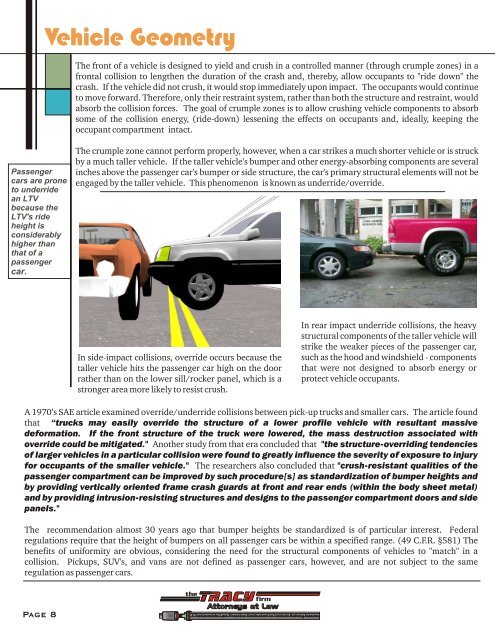Vehicle Aggressivity
Vehicle Aggressivity
Vehicle Aggressivity
- No tags were found...
You also want an ePaper? Increase the reach of your titles
YUMPU automatically turns print PDFs into web optimized ePapers that Google loves.
<strong>Vehicle</strong> GeometryThe front of a vehicle is designed to yield and crush in a controlled manner (through crumple zones) in afrontal collision to lengthen the duration of the crash and, thereby, allow occupants to "ride down" thecrash. If the vehicle did not crush, it would stop immediately upon impact. The occupants would continueto move forward. Therefore, only their restraint system, rather than both the structure and restraint, wouldabsorb the collision forces. The goal of crumple zones is to allow crushing vehicle components to absorbsome of the collision energy, (ride-down) lessening the effects on occupants and, ideally, keeping theoccupant compartment intact.Passengercars are proneto underridean LTVbecause theLTV's rideheight isconsiderablyhigher thanthat of apassengercar.The crumple zone cannot perform properly, however, when a car strikes a much shorter vehicle or is struckby a much taller vehicle. If the taller vehicle's bumper and other energy-absorbing components are severalinches above the passenger car's bumper or side structure, the car's primary structural elements will not beengaged by the taller vehicle. This phenomenon is known as underride/override.In side-impact collisions, override occurs because thetaller vehicle hits the passenger car high on the doorrather than on the lower sill/rocker panel, which is astronger area more likely to resist crush.In rear impact underride collisions, the heavystructural components of the taller vehicle willstrike the weaker pieces of the passenger car,such as the hood and windshield - componentsthat were not designed to absorb energy orprotect vehicle occupants.A 1970’s SAE article examined override/underride collisions between pick-up trucks and smaller cars. The article foundthat “trucks may easily override the structure of a lower profile vehicle with resultant massivedeformation. If the front structure of the truck were lowered, the mass destruction associated withoverride could be mitigated." Another study from that era concluded that "the structure-overriding tendenciesof larger vehicles in a particular collision were found to greatly influence the severity of exposure to injuryfor occupants of the smaller vehicle." The researchers also concluded that "crush-resistant qualities of thepassenger compartment can be improved by such procedure[s] as standardization of bumper heights andby providing vertically oriented frame crash guards at front and rear ends (within the body sheet metal)and by providing intrusion-resisting structures and designs to the passenger compartment doors and sidepanels."The recommendation almost 30 years ago that bumper heights be standardized is of particular interest. Federalregulations require that the height of bumpers on all passenger cars be within a specified range. (49 C.F.R. §581) Thebenefits of uniformity are obvious, considering the need for the structural components of vehicles to "match" in acollision. Pickups, SUV's, and vans are not defined as passenger cars, however, and are not subject to the sameregulation as passenger cars.Page 8thefirm



